A history of light in Renaissance art through Olafur Eliasson
The current show of Olafur Eliasson “In Our Time” at Palazzo Strozzi is the ground onto which to build a history of light in the Renaissance
The roots of the use of light in artistic production lay in the distant past. When tasked with the reconstruction of the Abbey of Saint-Denis, Abbot Suger decided to make light the main component of Gothic architecture, based on the Neoplatonic theory according to which light is a symbol and a visible manifestation of the divine, as well as a means to achieve spiritual elevation. [1] The iconic stained-glass windows of cathedrals are indeed a rare form of artistic object, for not only are they backlit, but they are also the object through which the light streams in from outside, creating a bright and colourful tapestry (just think of the apse in the Basilica of Santa Croce in Florence). Since the light changes according to the time of day, and as it is influenced by a variety of elements – such as the point of view of the observer, the direction of the light, and the weather – the ensuing works of art are constantly changing and evolving, [2] as are the installations of Olafur Eliasson.
During the second and third decades of the fifteenth century in Florence, the study of light and its symbolic significance transcended architecture and became extremely important in painting, too, in part owing to the influence of Flemish art, as described in Leon Battista Alberti’s De pictura. [3] Painters such as Beato Angelico and Piero della Francesca are in fact among the so-called “painters of light,” a definition coined to describe a brief but important moment in Florentine art in the mid-fifteenth century, when colours “are beaded with light and perspective becomes a sight for the eyes. Painting turns clear like a cloudless sky, like the spring air, and even the shadows become sharp and transparent.” [4]
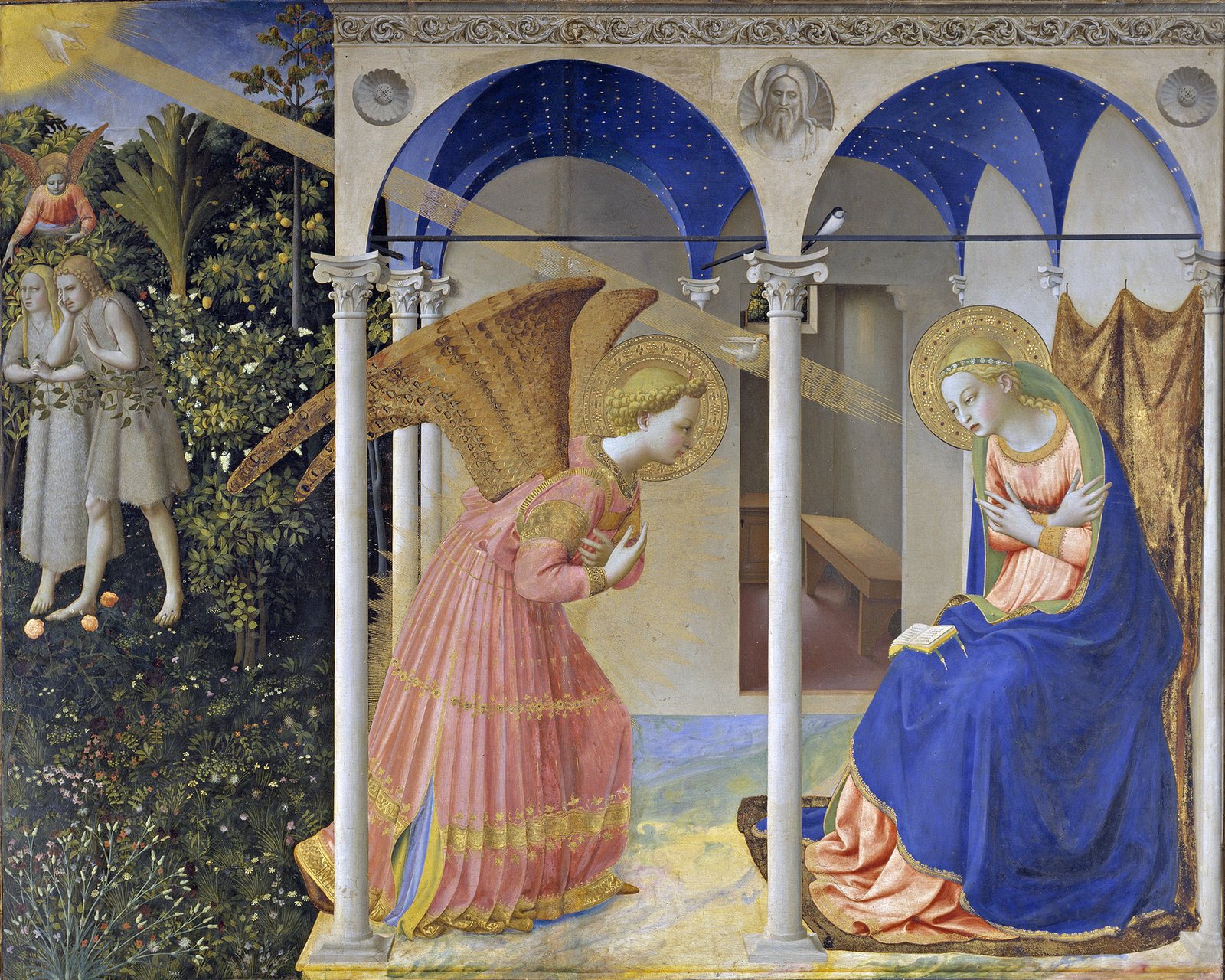
A divine ray of light descends from on high in the Annunciation painted by Fra Angelico for the Convent of San Domenico in Fiesole (ca. 1425–1426), [5] symbolizing Christ’s incarnation in the Virgin’s womb, while an earthlier light filters through the tiny window in the background. Similarly allusive of Mary’s miraculous conception is the light projected by the window in Piero della Francesca’s Madonna di Senigallia. In the back room that opens beyond the stone portal, Piero, who had a profound knowledge of optical and prospective effects, renders with great realism the dust motes dancing in the golden ray of light projected on the wall, at the same time endowing them with metaphorical significance. The light is divvied up by the lead came, much like the effect obtained by Eliasson in his Triple window projection (1999) or in the aforementioned Triple seeing survey (2022), but also in Love sees with eyes, not with mind (1999), [6] an earlier artwork Eliasson first showed at Galleria Emi Fontana in Milan.

Three spotlights on the opposite side of the courtyard shine into the room through the large existing windows, which have been cropped and reframed. As a result, they cast a grid of light onto the wall, conjuring up a set of surrogate windows which magnify the irregularities in the centuries-old glass. As visitors cross the space, they find themselves immersed in a dialogue between artificial and natural light, and between real and projected spaces and openings. A typical feature of Palazzo Strozzi is the interplay between its interior and exterior space created by the large windows that overlook the courtyard and light its rooms in a way that constantly changes throughout the day. Eliasson intercepts this architectural dynamic with an intervention that purposely uses the physical quality of the glass, its leaden profiles apportioning the light source into squares. The lights reveal the irregularities in the glass, the bubbles, the scratches and the dust, thereby highlighting its texture and allowing viewers to gain an awareness of the glass as the membrane separating the interior from the exterior. This “mediating” surface plays a crucial, protective role but it also permits visual communication.
Filippo Lippi also played a role in the establishment of this form of “tangible and transparent” painting strongly based on light, a blatant example of which is the glass guastada (or vase) in his Martelli Annunciation, in which the surrounding rooms are reflected, and the shadow it casts on the floor. This prism alludes once again to the Immaculate Conception – the light metaphorically flowing through the glass and leaving it untarnished: [7] this image visually reminds us of Eliasson’s works, although he is more interested in the viewer’s perception, focusing on immanence and entanglement, not transcendence and the divine.
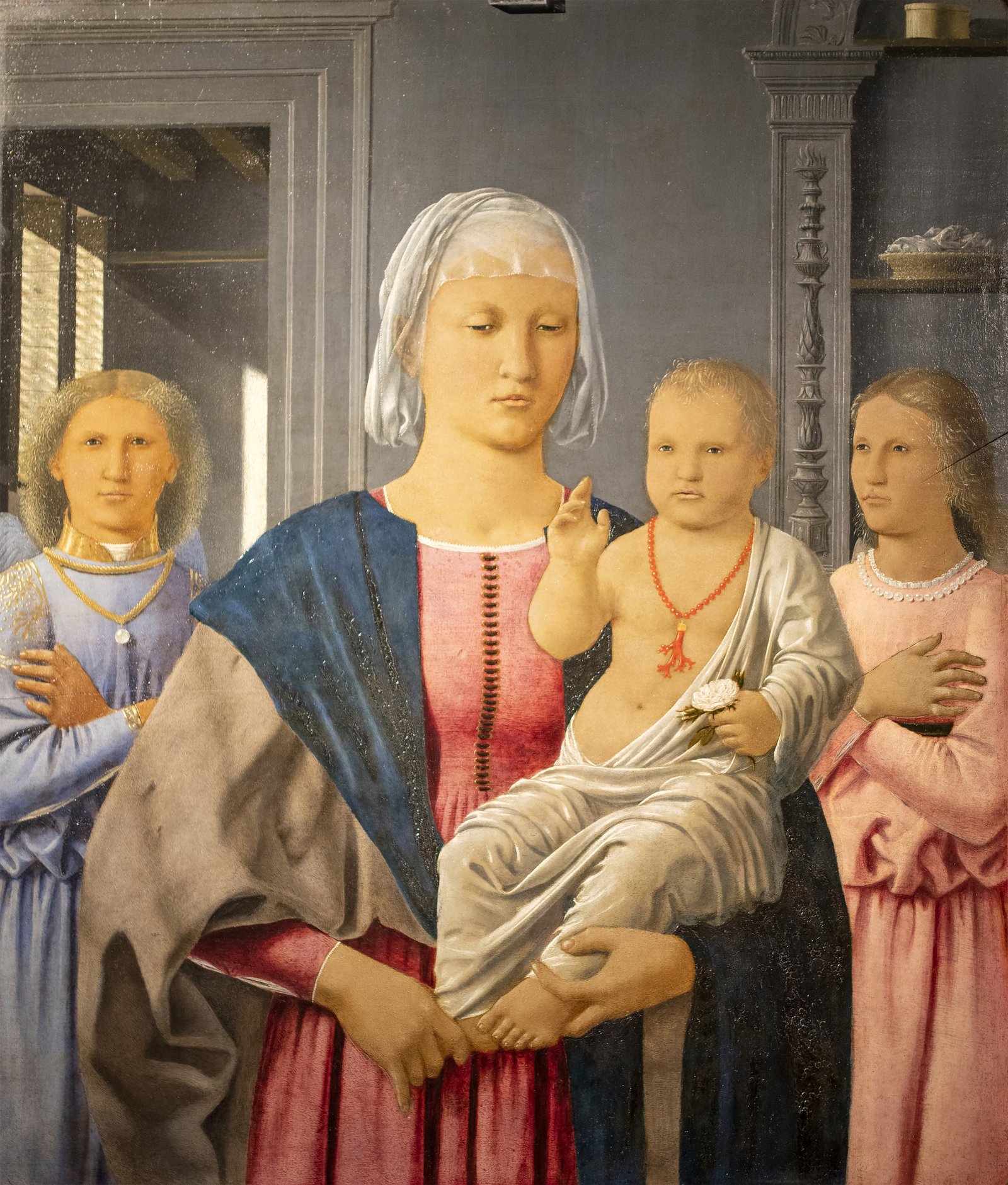
Several of Eliasson’s works in which light plays a central role, such as Tomorrow (2022), are characterised by the presence of stark shadows, an element that has interested and involved many artists throughout the history of art, albeit in very different ways. [8] Shadows are considered to have determined the very birth of drawing, one of the founding elements of Florentine art, as recounted in a legend described by Pliny in his Naturalis historia and depicted by Giorgio Vasari in the frescos of the Great Hall of his Florentine home: a boy kneeling before a lamp, tracing his own shadow with a piece of charcoal. [9] According to the definition offered by Filippo Baldinucci, [10] a “form” shadow is what appears on an object in the portion where the light reaches it with minor intensity, while a “cast” shadow is the shadow projected on a surface by an object standing between the light source and the surface itself, playing a crucial role in the rendering of space and light. Often “cast shadows” take on a symbolic significance, as is the case with the shadow cast by Saint Peter healing a sick man in one of the stories painted by Masaccio in the Cappella Brancacci.
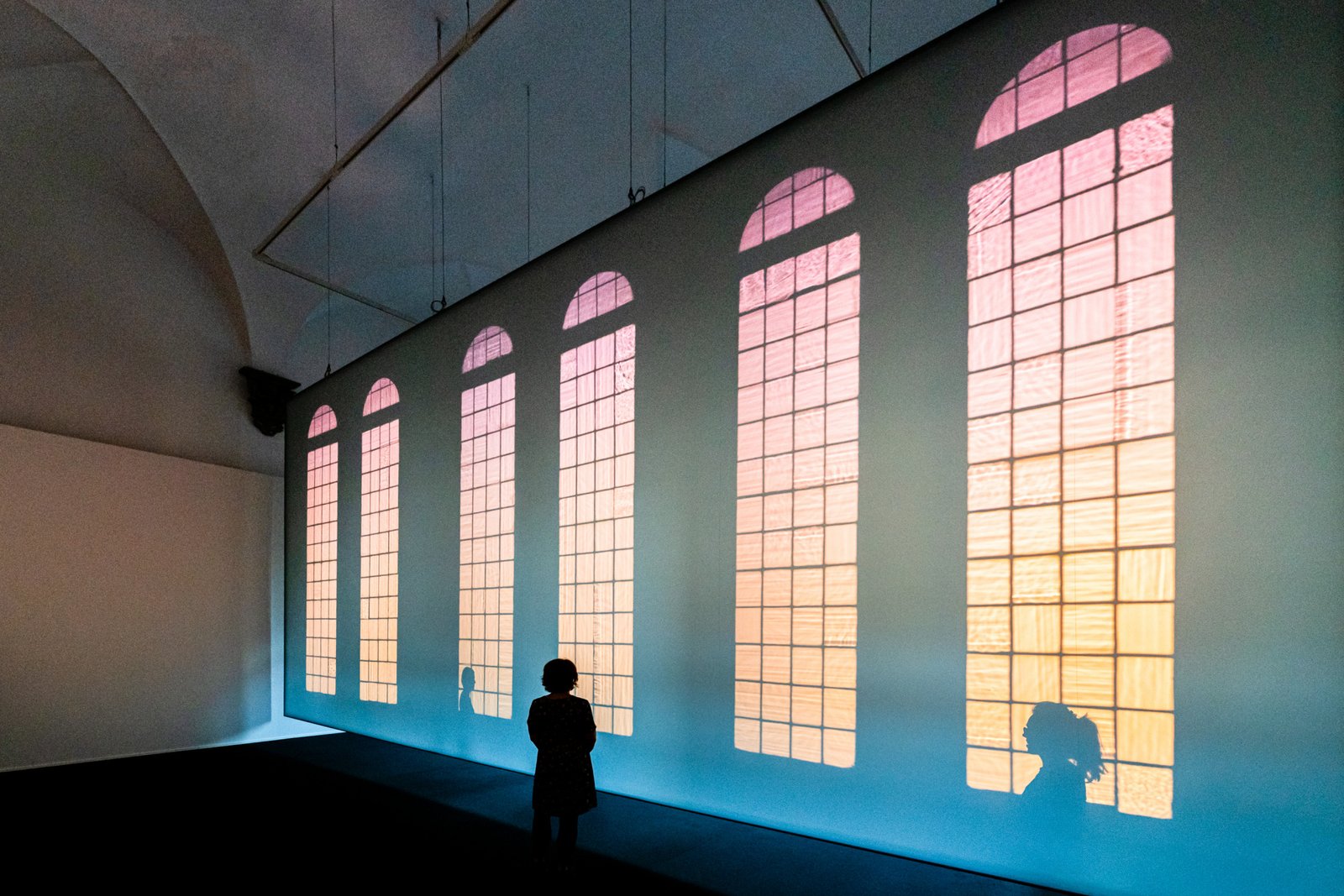
Light projected through the windows of Palazzo Strozzi from a building across the street casts a window- shaped pattern onto a screen that divides the room in two. Special filters attached to the spotlights produce in the projection a colourful fade that is reminiscent of a sunset or sunrise. Visitors entering the room can see the silhouettes and ankles of people on the other side of the screen, but it is not immediately clear how they can access that space until they move to the next room. The work reflects Eliasson’s long fascination with the atmospheric effects of light, translating it into a physical and visual deconstruction of Palazzo Strozzi as an architecture of changing and changeable light, in which visitors are called on to play a leading role.
Eliasson’s investigation into shadows can be once again likened to Leonardo’s, to whom we owe some dazzling intuitions and the first experiments with light reflecting off a coloured surface and projected onto a white surface. In his Treatise on Painting, Leonardo imagines a green effect obtained by mixing yellow and blue reflections on a white surface, or using a light-blue surface that would reflect the sunlight (turning it blue) onto a yellow surface, turning it green. A drawing in the Codex Atlanticus depicts the projection of three coloured lights onto a white sphere, differentiating the effects of each light and the three various combinations. [11] These studies by Leonardo remind us of works such as Your uncertain shadow (colour) (2010), in which Eliasson lined up coloured spotlights on the floor and pointed them at a white wall. Seen together, these colours produce a bright white light that is cast on the wall. When visitors access this space, their shadows will block the path of each coloured light from a slightly different angle and appear on the wall in the form of differently coloured silhouettes. Aside from the darker shadow created where all lights encounter an obstacle, the colours of the other shadows reflect the properties of the additional colour. While visitors move through the space, moving closer to and farther from the lights, their silhouettes change in intensity and colour.
[Here is our interview with Olafur Eliasson. Ed.]
Where light is an element of primary importance in Renaissance painting, colour, enhanced by this same light, also holds a powerful symbolic significance. According to Thomas Aquinas, a colour will display a varying degree of participation in the divine essence depending on the amount of light it absorbs and reflects – this is why painters would use white for Christ’s robes and surround saints with auras of light. Where Fra Angelico employed bright pigments and precious materials, Piero della Francesca, a precursor in the use of oil, had a more scientific approach, using balanced and complementary colours. Much like Piero, Eliasson’s interest in colour theory and perception “comes from investigations into how the eye functions and how one can use colour to explore the differences in what we see.” [12] For this reason, he has endeavored to outline a new colour theory based on prismatic colours, working with a colour chemist to create paints of the exact colour of every nanometer of light in the visible spectrum, then using this palette to create his Colour experiment paintings, some of which are inspired by the palettes used by artists of the past such as Joseph Mallord William Turner, Caspar David Friedrich, or Claude Monet.

Room for one colour (1997), which uses monofrequency lamps to cancel out all perception of colour, turning the world in monochrome in our eyes as if we were inside a grisaille painting, [13] is also based on similar studies. Furthermore, according to Eliasson, “the experience of being in a monochrome space of course varies for each visitor, but the most obvious impact of the yellow light is the realisation that perception is acquired: the representational filter, or the sudden feeling that our vision simply is not objective, is brought to our awareness, and with that our ability to see ourselves in a different light.” [14] As visitors move through this space, they may feel invited to reflect on their relationship with the environment; they might notice a transformation of their perception, a heightened awareness, which Eliasson has called “seeing yourself sensing.”
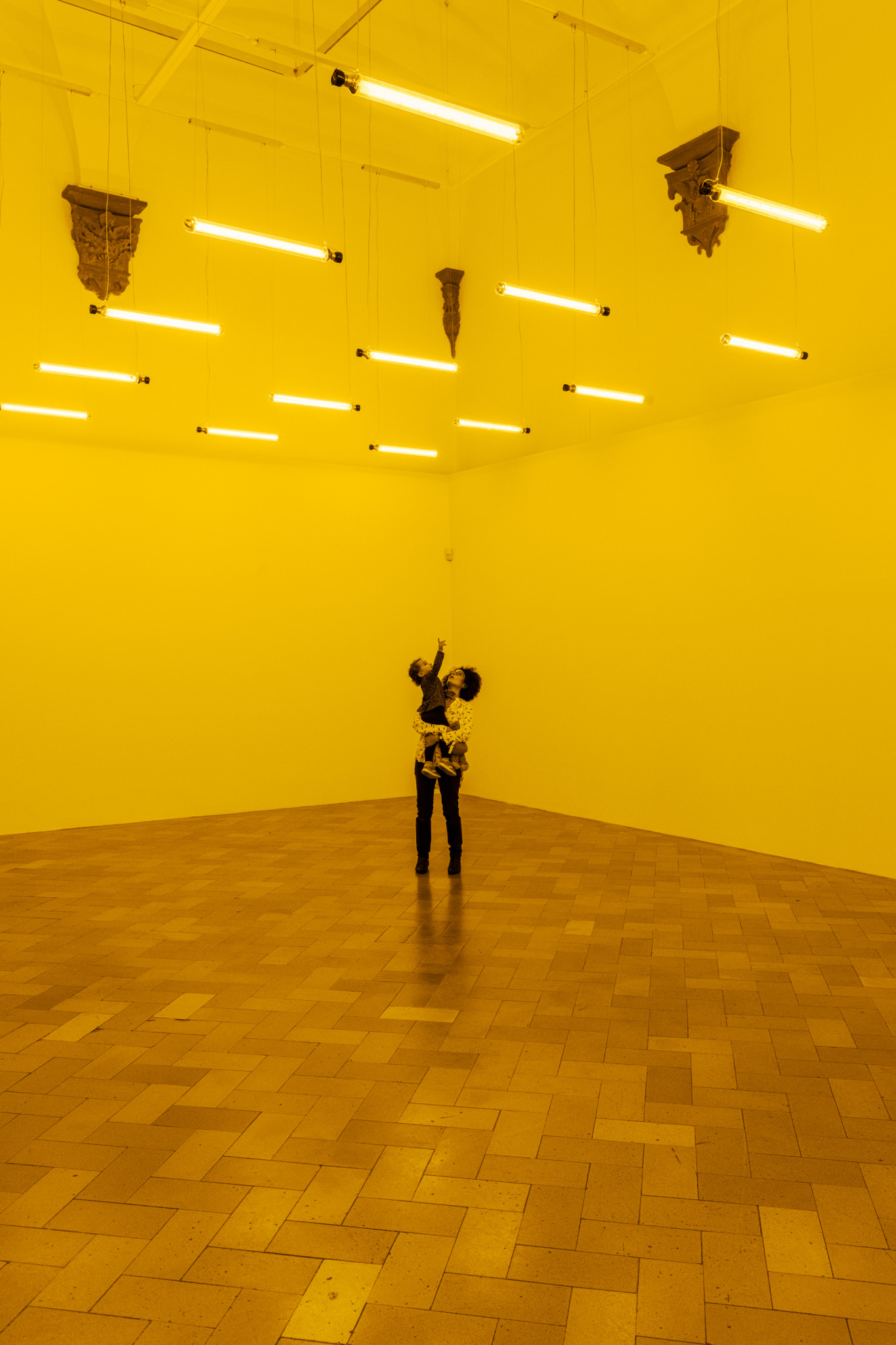
Monofrequency lights mounted on the ceiling of the room emit a narrow range of yellow light, reducing viewers’ colour perception to shades of yellow and black. In the artist’s own words: “the experience of being in a monochrome space of course varies for each visitor, but the most obvious impact of the yellow light is the realisation that perception is acquired: the representational filter, or the sudden feeling that our vision simply is not objective, is brought to our awareness, and with that our ability to see ourselves in a different light.” The longer the viewers stay in the space, the more they begin to perceive subtle colour distinctions and to correct for the yellowish lighting. Upon leaving, they momentarily perceive a bluish afterimage.
Mirrors, much employed by Eliasson in works such as Red window semicircle (2008), Solar compression (2016), and How do we live together? (2019), have a long tradition of use in the history of art. In Florence, mirrors played a fundamental role in the evolution of perspective. Filippo Brunelleschi used a mirror – an element in an optical system that reminds us of the one observed in Your circumspection disclosed (1999) – in his first perspective tablets, now long lost, depicting the Baptistery and Palazzo della Signoria. Mirror effects are crucial in How do we live together? (2019), a composition based on two circles, with a semicircular metal structure that intersects a large mirrored surface in the ceiling in which it is reflected. While involving visitors in the artwork, it also generates a trompe l’oeil effect that gives the room greater depth.
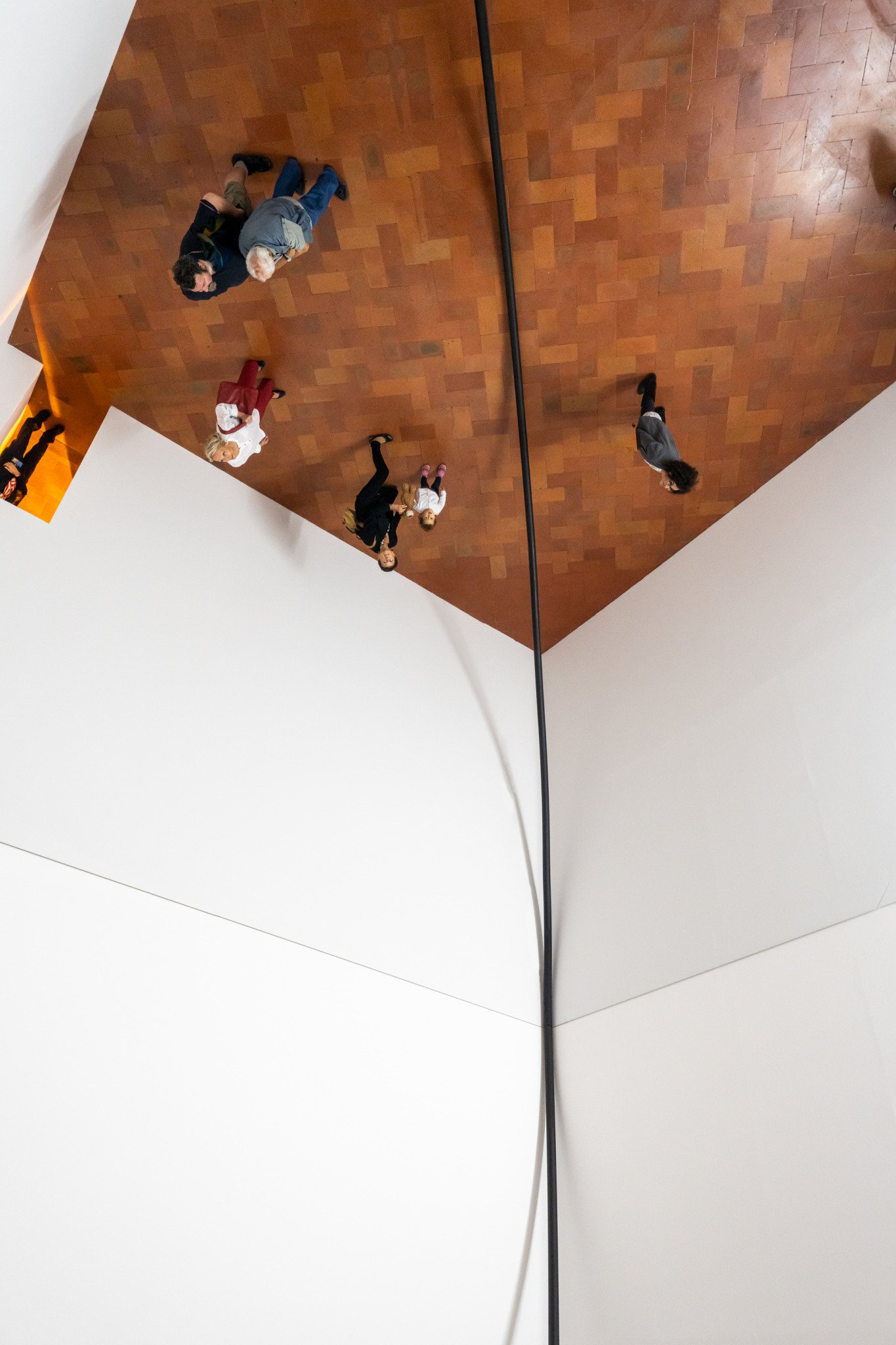
A black, semi-circular arc is mounted on a mirror on the ceiling, from which it extends down to touch the floor at a single point. The semicircle visually combines with its reflection to give the illusion of a giant ring traversing the mirror’s surface and uniting the real space of the room with the reflected space. A moment of alienation and disorientation is triggered when viewers recognise themselves floating upside down in the mirror above, sharing the space with the ring that seems to bridge the two worlds.
Optical devices that fragment and multiply reflections – such as Colour spectrum kaleidoscope (2003) and Firefly double-polyhedron sphere experiment (2020) – represent an important aspect in Eliasson’s artistic research. Though their purpose is a sensorial exploration rather than the investigation of the skies, their appearance is that of descendants of the wonderfully shaped scientific instruments – armillary spheres, as- trolabes, spyglasses, and telescopes – invented and employed by pioneering scientists such as Galileo Galilei and Evangelista Torricelli, [15] both based in Florence.
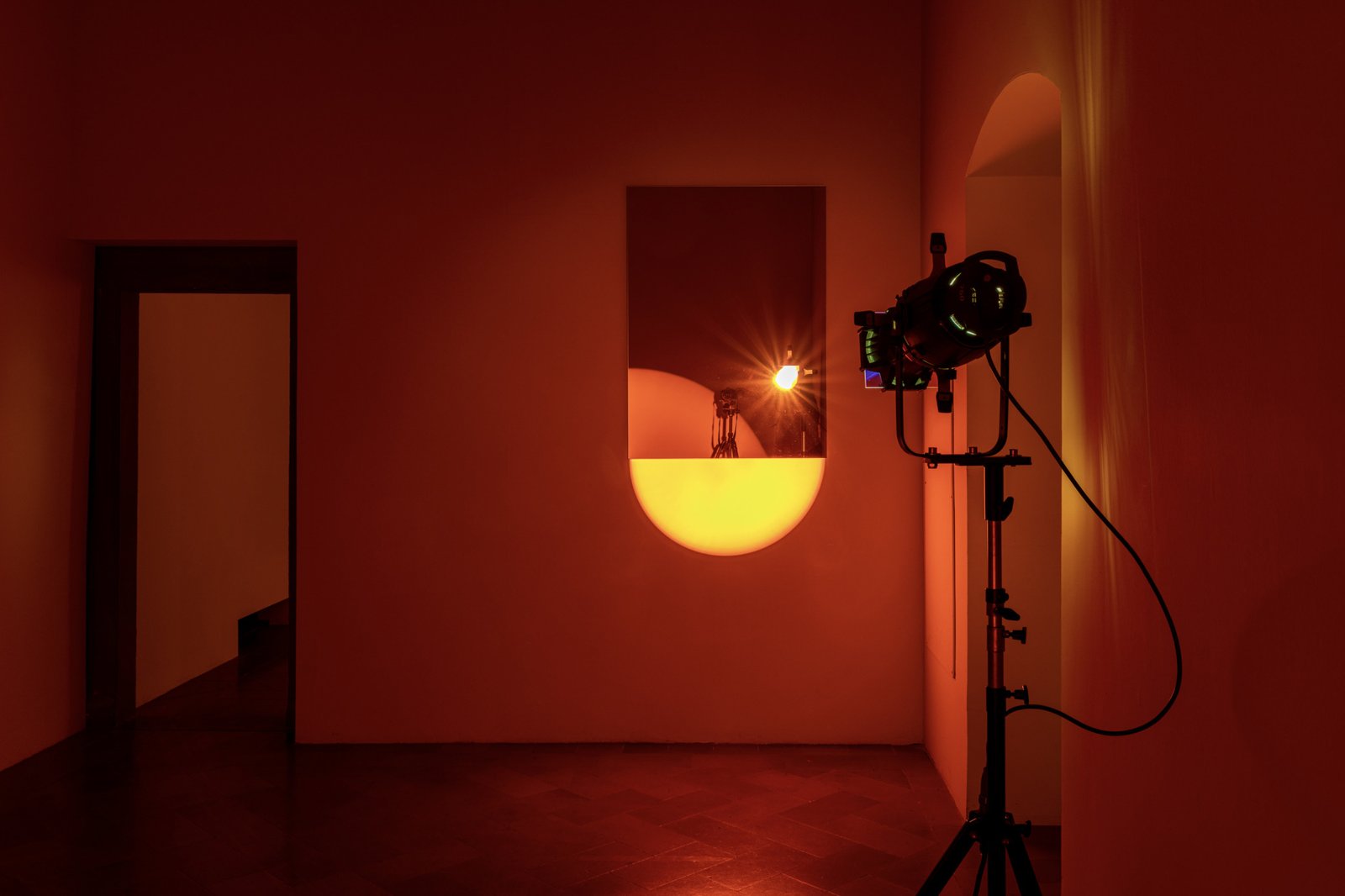
A spotlight filtered by a red colour-effect filter glass illuminates a small mirror. The circle of light is cut in half by the mirror, causing one semicircle to appear just below the mirror while the other half is reflected by the mirror and appears, enlarged, at the base of the opposite wall. The resulting semicircle of light resembles a small sunset, and is reminiscent of Eliasson’s celebrated The weather project, shown at Tate Modern in London in 2003.
The weather project (2003), the very successful installation created for the Turbine Hall at Tate Modern in London, also employed an extensively mirrored ceiling to create the illusion of the sun, of a gigantic, never- ending sunset viewed through the haze, an effect enhanced by the use of a semicircular screen and artificial mist. Looking back from where we stand today, this powerful image might evoke issues such as climate change, as well as our individual perception of nature and the weather.
Having lived at northern latitudes, in Iceland and in Denmark, Eliasson possesses a very developed sensitivity when it comes to natural phenomena that are the main themes of Din blinde passager (Your blind passenger) (2010), in which a fine mist filling up a long, narrow space is lit by a sequence of coloured lights, blinding visitors and requiring them to trust in their other senses to find their bearings. In Eliasson’s production, the first of these weather-based installations was the poetic work Beauty (1993), in which each viewer could find their own rainbow depending on the point of view from which they observed the piece.
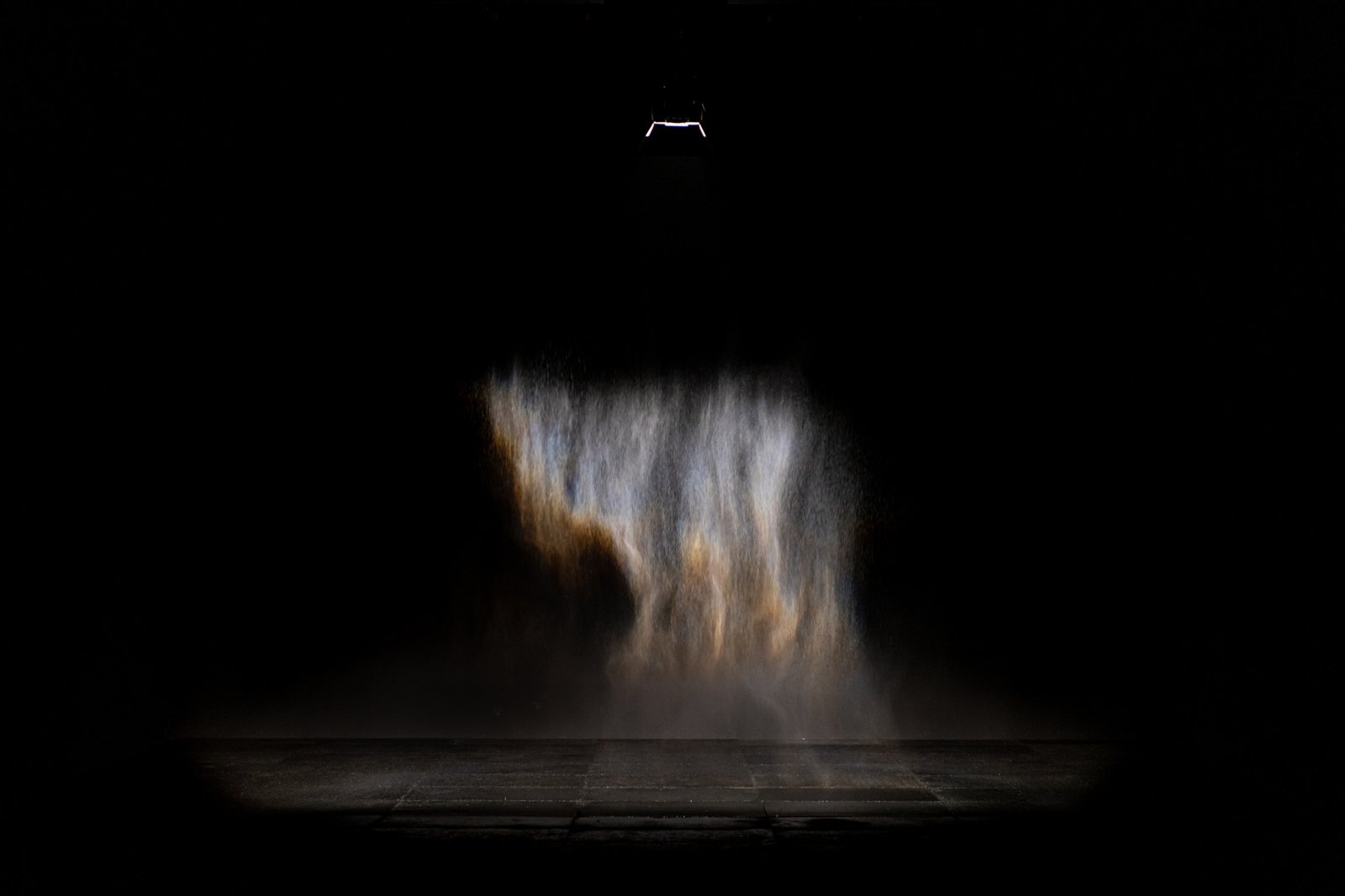
Bands of coloured light shimmer in a curtain of mist. This apparition depends on the light projected from a precisely angled spotlight, as refracted and reflected by the water droplets, meeting the eye of the viewer. The resulting rainbow changes depending on the viewer’s position; no two viewers see the same rainbow. As Eliasson says: “It is a matter of fluctuating back and forth between two positions: seeing the rainbow, not seeing the rainbow, seeing and not seeing.” Beauty is an articulation of Eliasson’s idea that the viewer is always a necessary co-producer of the artwork.
When confronted with visual effects such as those present in Beauty (1993), our thoughts once again go to Leonardo and his interest in atmospheric phenomena and their depiction, which emerges in several chapters of his Treatise on Painting; [16] or to the “atmospheric haze” obtained in painting with the infinitesimal graduation of light vibrations. On the subject of aerial perspective, Leonardo wrote about the “vast amount of air that stands between your eye and said mountains” that appear “azure, nearly the colour of air, when the sun is in the east,” [17] as well as the amount of water that fills the atmosphere.
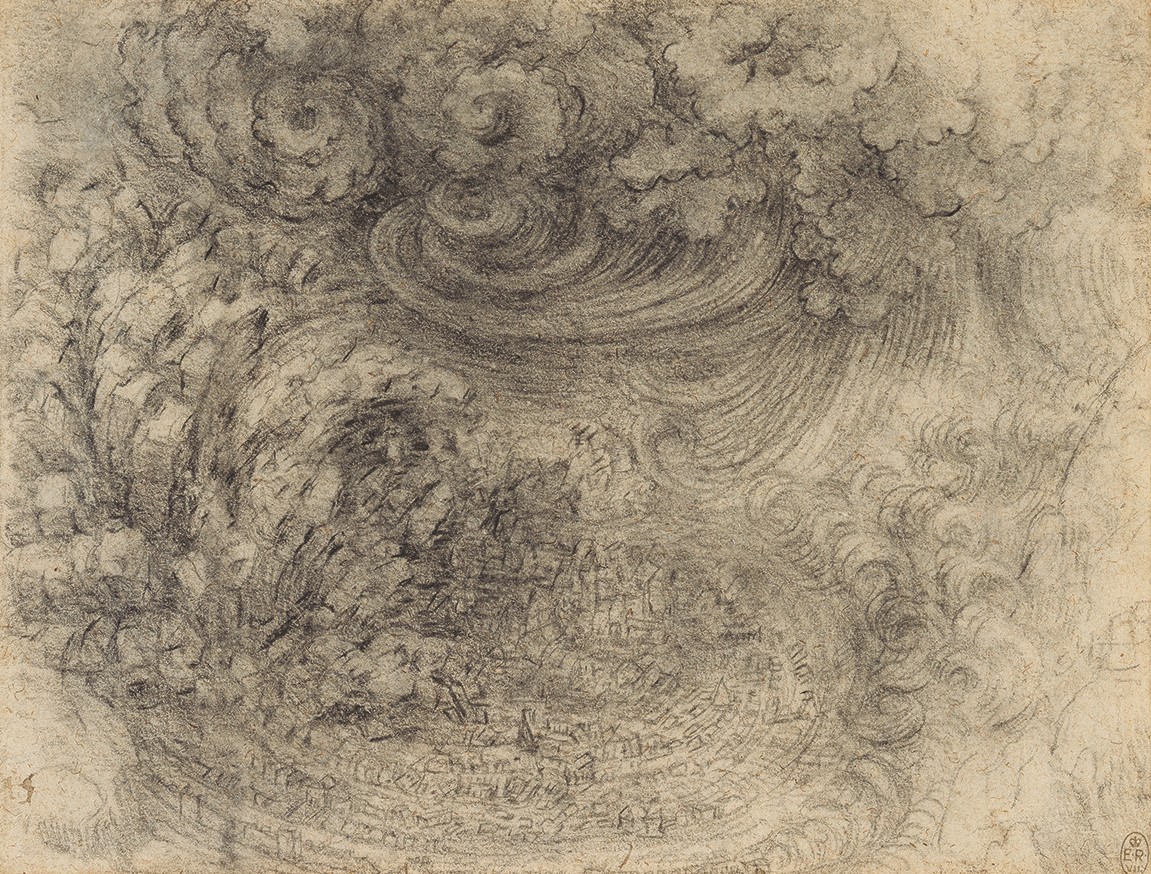
Leonardo’s interest in water and his studies of rivers, such as his observations aimed at rendering the Arno navigable or regulating the Lombard watercourses, are echoed in Green river (1998–2001), in which Eliasson used fluorescein to dye the rivers of several cities green to raise awareness about the relationship between humanity and the environment. Leonardo’s fascination for waterfalls, described in the Codex Atlanticus, [18] is reiterated in some of Eliasson’s most famous works, such as the huge waterfalls built along the East River (2008), in Versailles (2016), or at Tate Modern (2019). During the last years of his life, Leonardo obsessively drew vortices and storms sweeping across the landscape. In a sheet depicting a mountain that is about to collapse on a city in a tremendous spiral of energy, the scientific analysis of the motion of the water makes way for a sense of precarity in the face of the power of nature.
We find this theme in Olafur Eliasson as well, updated and connected to the pressing graveness of the climate change we are experiencing, as well as the desire to raise the public’s awareness of the subject of global warming, which becomes obvious when observing the agony of melting glaciers. The artist devoted a famous and controversial installation to this theme: Ice Watch (2014), in which he brought 12 (or 24) massive icebergs, broken off from the ice cap in Greenland, to Copenhagen, Paris, and London, making the issue of global warming very concrete and visible to all.
We could continue listing the analogies, but I have no desire to push Eliasson into a time frame that is not his own. To put it in the artist’s words:
Leonardo and the Renaissance rendered the world visible, but they operated in a centralised era, with a hierarchic, militaristic view of knowledge […]. Leonardo studied the mechanics of muscles and art, I am more interested in the psychological and social aspects of art and nature. That is why I build bridges and façades that breach the distance between people and favour inclusion. [19]
[1] See also Erwin Panofsky, Abbot Suger on the Church of Saint-Denis (Princeton, NJ: Princeton University Press, 1946).
[2] Takuma Ito, La vetrata nella Toscana del Quattrocento (Florence: Olschki, 2011).
[3] Paula Nuttall, “Pittura degli antichi Paesi Bassi a Firenze: commentatori, committenti e influsso,” in Firenze e gli antichi Paesi Bassi, 1430 –1530, dialoghi tra artisti: da Jan van Eyck a Ghirlandaio, da Memling a Raffaello…, edited by Bert W. Mejer (Livorno: Sillabe, 2008), 22–37. Exhibition catalog, Galleria Palatina, Palazzo Pitti, Florence, June 20–October 26, 2008).
[4] Luciano Bellosi, in Pittura di luce. Giovanni di Francesco e l’arte fiorentina di metà Quattrocento, edited by Luciano Bellosi (Milan: Olivetti-Electa, 1990), 11–12. Exhibition catalog, Casa Buonarroti, Florence, May 16– August 20, 1990.
[5] See Fra Angelico “The Annunciation Altarpiece” in the Museo del Prado, curated by Carl Brandon Strehlke (Madrid: Museo Nacional del Prado, 2019).
[6] Luciano Bellosi, “Sulla formazione fiorentina di Piero della Francesca,” in Una scuola per Piero. Luce, colore e prospettiva nella formazione fiorentina di Piero della Francesca, edited by Bellosi (Venice: Marsilio, 1992), 43– 44. Exhibition catalog, Galleria degli Uffizi, Florence, September 27, 1992–January 10, 1993.
[7] Though for a long time Lippi was not considered among the “painters of light,” especially because of his later works, his crucial role in the development of this style is now broadly acknowledged. See Neville Rowley, “Una pittura di luce,” in Intorno all’Annunciazione Martelli di Filippo Lippi. Riflessioni dopo il restauro, edited by Monica Bietti (Florence: Mandragora, 2018), 155–163 (159).
[8] See also Ernst H. Gombrich, Shadows: The Depiction of Cast Shadows in Western Art, with an introduction by Nicholas Penny and a preface by Neil McGregor (New Haven, CT: Yale University Press, 2014); and Victor Stoichita, A Short History of the Shadow (London: Reaktion Books, 1997).
[9] See also Eliana Carrara, “Plinio e l’arte degli antichi e dei moderni. Ricezione e fortuna dei libri XXXIV-XXXVI della ‘Naturalis Historia’ nella Firenze del XVI secolo (dall’Anonimo Magliabechiano a Vasari),” in Archives Internationales d’Histoire des Sciences, vol. 61, no. 166–167 (June–December 2011): 367–381 (372); Lorenzo Ratto, La notte moderna. Pittura dell’oscurità nel Cinquecento (PhD diss. in Study and Appreciation of the Historical, Artistic, Architectural, and Environmental Heritage, Università degli Studi di Genova, 2020), 115–117.
[10] Filippo Baldinucci, Vocabolario toscano dell’arte del disegno, Florence, for Santi Franchi al segno della Pas- sione, 1681, 111. Baldinucci’s term for cast shadows is “sbattimento.”
[11] Leonardo da Vinci, A Treatise on Painting, paragraphs 162 and 163. See also Corrado Maltese, “Leonardo e la teoria dei colori,” in Römisches Jahrbuch für Kunst-geschichte 20 (1983): 209–219 (214).
[12] Studio Olafur Eliasson: An Encyclopedia (Cologne: Taschen, 2012), 93.
[13] Leila Packer and Jennifer Sliwka, Monochrome: Painting in Black and White (London: National Gallery Company Limited), 2017. Exhibition catalog, The National Gallery, London, October 30, 2017–February 18, 2018.
[14] “457 Words on Colour,” in Bridge the Gap?, edited by Akiko Miyake, Hans Ulrich Obrist, and Scott Olson (Kitakyushu: Center for Contemporary Art, 2001), 76–77.
[15] See also Paolo Galluzzi, ed., Galileo. Images of the Universe from Antiquity to the Telescope (Florence: Giunti, 2009), 247–253, 307–322, 347–349. On the lens, see p. 349. Exhibition catalog, Palazzo Strozzi, Florence, March 13–August 30, 2009.
[16] The treatise was compiled after his death, in ca. 1540, based on his notes, see Leonardo da Vinci, A Treatise on Painting, vol. II, part III, chapters 452, 457– 460.
[17] Leonardo da Vinci, A Treatise on Painting, vol. II, chapter 258.
[18] Water Studies (Windsor: Royal Library), see Carlo Pedretti, The Drawings and Miscellaneous Papers of Leonardo Da Vinci in the Collection of Her Majesty the Queen at Windsor Castle: Landscapes, Plants and Water Studies (Windsor: Johnson Reprint Company, 1982).
[19] Stefano Savastano, “Olafur Eliasson si racconta,” L’Espresso, December 3, 2015, accessed August 4, 2022, espresso.repubblica.it/plus/articoli/2015/11/30/news/intervista-a-olafur-eliasson-1.238829/.
October 20, 2022
